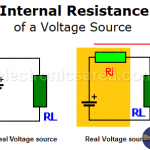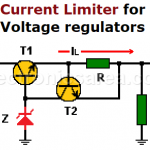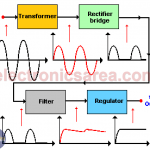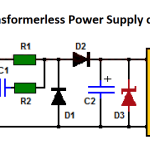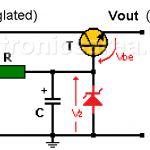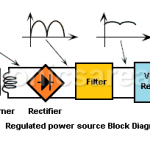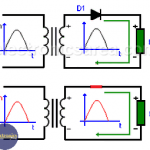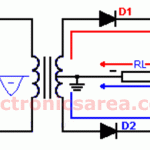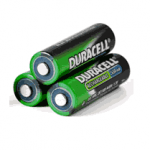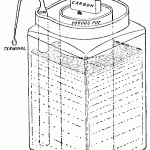Voltage sources, whether batteries, generators, etc., are not ideal (perfect). A real voltage source is composed of an ideal voltage source in series with a resistance called internal resistance.
Current Limiter circuit for Power Supply using transistor & resistor
Current Limiter circuit for a Power Supply using a transistor and a resistor.
If the load current exceeds its maximum, an over current protection is needed
Power Supply – Block Diagram (AC – DC conversion process)
Many electronic circuits need a direct current (DC) voltage source, but what we commonly find are voltage sources of alternating current (AC). In order to achieve a direct current voltage source, the alternating current input must follow a conversion process.
Transformerless Power Supply Circuit Diagram
This circuit is designed to connect to a specific circuit because it can only provide a maximum and minimum current.
Transistorized Voltage Regulator (Zener & Transistor)
Explanation of a transistorized voltage regulator. Zener diode and transistor voltage regulator circuit diagram
Zener diode Voltage regulator Circuit Design – Diagram
Design method. Determination of the voltage, power of the zener diode and of the limiting resistor Rs
Voltage Regulators – Linear, Switching
Voltage regulators (linear, switching) provide a stable and fixed voltage output to give energy to electronics circuits from an unregulated power source
Half Wave Rectifier – Half-wave Rectifier. Circuit diagram
The half-wave rectifier rectification process. Polarization of semiconductor diode in the forward and in the reverse direction. Input and output waveforms
Full Wave Rectifier using center tapped transformer
This full wave rectifier requires a center tapped transformer. This additional end on the secondary winding of the transformer divides the voltage in this winding into two equal voltages. The additional end is grounded.
Types of Cells / Batteries
Types of cells / batteries. Primary batteries (non-rechargeable): Dry, mercury, alkaline. Secondary batteries (rechargeable): Nickel-Cadmium Alkaline, Lead
How does a battery work?
The electric current is a flow of electrons that flow through a conductor cable. Electrons are negatively charged, and like two magnets that we want to put together, negative side with negative side or positive side with positive side, they repel.

